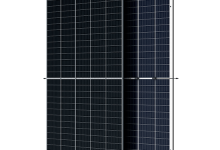Trina Solar has unveiled a new range of high-efficiency solar modules with more than 500 watts per module – compared to the current industry standard of mid 300Ws – and the promise to further cut the costs of generating solar power.
The modules use the PERC solar cell design pioneered by the University of New South Wales, and are expected to deliver a solar conversion efficiency of up to 21 per cent.
Trina has launched two new model types, the latest versions of the Duomax V bifacial double-glass modules and the Tallmax V back sheet modules. Both sets of modules feature large, 210mm solar cells.
By upscaling the size of the panels, Trina hopes to cut the balance of system costs for a solar system installation by 6 to 8 per cent, reducing the overall cost of a solar installation by 3 to 4 per cent.
“I believe our new modules will bring the photovoltaic market to the next stage,” Trina Solar vice general manager Yin Rongfang said.
“We hope to drive the standardisation of modules through our design and manufacturing advantages, which will not only benefit many segments in the industrial chain, but also enhances the design commonality of modules on the system side.
“In addition to the product itself, a good module requires consideration of its matching capability with existing systems.
“We explored and solved the potential challenges that could arise in the practical application of the system early in the research and development stage, and fully tapped the potential of the product,” Yin said.
The release of the 500W panel by China’s Trina follows module releases from both Longi and Jinko in 2019, the latter with the October launch of its Mono PERC 460W “Tiger,” with efficiency of just over 20 per cent.
Longi, in August, launched the sleek-looking, high-efficiency Hi-MO X in 400W (72-cell) and 350W (60-cell) peak power variants, with a conversion rate of 20 per cent.
Trina expects to begin taking orders for its new panels in Q2 2020, and is aiming to ramp up production of the panels to more than 5,000MW by the end of the year.
To read the original story on RenewEconomy sister site One Step Off The Grid, click here…










